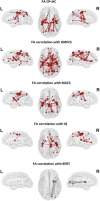Whole-brain structural connectivity in dyskinetic cerebral palsy and its association with motor and cognitive function
- PMID: 28608616
- PMCID: PMC6866837
- DOI: 10.1002/hbm.23686
Whole-brain structural connectivity in dyskinetic cerebral palsy and its association with motor and cognitive function
Abstract
Dyskinetic cerebral palsy (CP) has long been associated with basal ganglia and thalamus lesions. Recent evidence further points at white matter (WM) damage. This study aims to identify altered WM pathways in dyskinetic CP from a standardized, connectome-based approach, and to assess structure-function relationship in WM pathways for clinical outcomes. Individual connectome maps of 25 subjects with dyskinetic CP and 24 healthy controls were obtained combining a structural parcellation scheme with whole-brain deterministic tractography. Graph theoretical metrics and the network-based statistic were applied to compare groups and to correlate WM state with motor and cognitive performance. Results showed a widespread reduction of WM volume in CP subjects compared to controls and a more localized decrease in degree (number of links per node) and fractional anisotropy (FA), comprising parieto-occipital regions and the hippocampus. However, supramarginal gyrus showed a significantly higher degree. At the network level, CP subjects showed a bilateral pathway with reduced FA, comprising sensorimotor, intraparietal and fronto-parietal connections. Gross and fine motor functions correlated with FA in a pathway comprising the sensorimotor system, but gross motor also correlated with prefrontal, temporal and occipital connections. Intelligence correlated with FA in a network with fronto-striatal and parieto-frontal connections, and visuoperception was related to right occipital connections. These findings demonstrate a disruption in structural brain connectivity in dyskinetic CP, revealing general involvement of posterior brain regions with relative preservation of prefrontal areas. We identified pathways in which WM integrity is related to clinical features, including but not limited to the sensorimotor system. Hum Brain Mapp 38:4594-4612, 2017. © 2017 Wiley Periodicals, Inc.
Keywords: cerebral palsy; cognition; diffusion MRI; fractional anisotropy; graph theory; motor function; network-based statistic; structural connectome; white matter injury.
© 2017 Wiley Periodicals, Inc.
Conflict of interest statement
None of the authors have any conflict of interest to report.
Figures



References
-
- Abbruzzese G, Berardelli A (2003): Sensorimotor integration in movement disorders. Mov Disord 18:231–240. - PubMed
-
- Andersson JLR, Skare S (2002): A model‐based method for retrospective correction of geometric distortions in diffusion‐weighted EPI. Neuroimage 16:177–199. - PubMed
-
- Aravamuthan BR, Waugh JL (2016): Localization of basal ganglia and thalamic damage in dyskinetic cerebral palsy. Pediatr Neurol 54:11–21. - PubMed
-
- Arnfield E, Guzzetta A, Boyd R (2013): Relationship between brain structure on magnetic resonance imaging and motor outcomes in children with cerebral palsy: A systematic review. Res Dev Disabil 34:2234–2250. - PubMed
-
- Arrigoni XF, Peruzzo XD, Gagliardi XC, Maghini XC, Colombo XP, Iammarrone XFS, Pierpaoli XC, Triulzi XF (2016): Whole‐brain DTI assessment of white matter damage in children with bilateral cerebral palsy: Evidence of involvement beyond the primary target of the anoxic insult. Pediatrics 37:1347–1353. - PMC - PubMed
Publication types
MeSH terms
LinkOut - more resources
Full Text Sources
Other Literature Sources
Medical
Miscellaneous

